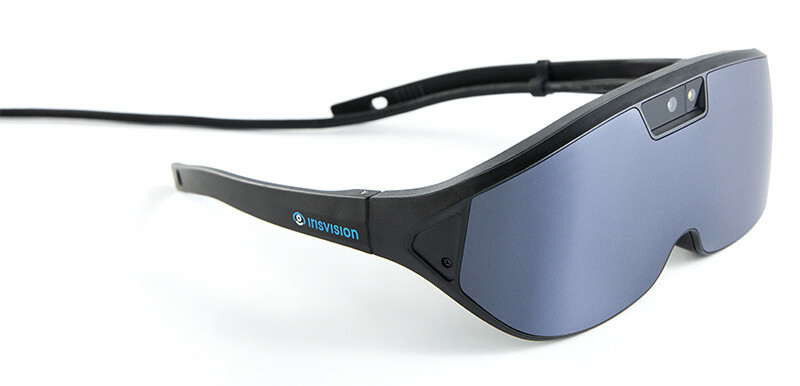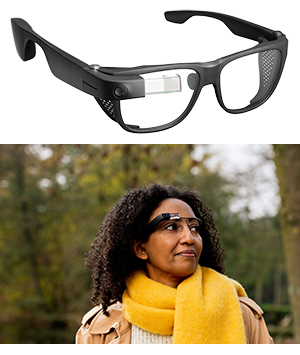How Smart Glasses for the Visually Impaired Are Revolutionizing Daily Life
How Smart Glasses for the Visually Impaired Are Revolutionizing Daily Life
Blog Article
Empowering Self-reliance With Assistive Technology for the Blind
The integration of assistive modern technology for people that are aesthetically impaired or blind represents a significant innovation in promoting self-reliance and enhancing lifestyle. With a variety of tools-- from screen readers to innovative tactile tools-- these innovations not just promote navigation and communication however also promote social inclusion and involvement in numerous elements of life. As we discover the diverse kinds of assistive gadgets and their real-world applications, it ends up being clear that the effect is profound. The development of this technology increases critical questions concerning availability and future advancements that necessitate more examination.
Comprehending Assistive Innovation
Although assistive innovation has advanced dramatically over the years, its essential objective continues to be the same: to improve the high quality of life for individuals with specials needs, especially those that are visually impaired or blind. This modern technology includes a broad series of devices and devices that assist in freedom and capability in everyday tasks.
Assistive innovation can be categorized right into low-tech and sophisticated remedies, each made to satisfy details needs. High-tech gadgets typically include software applications, specialized hardware, and adaptive tools that use advanced innovation to offer assistance in numerous contexts. On the other hand, low-tech services might entail day-to-day things that are modified to enhance availability, such as magnifiers or responsive pens.
The combination of assistive technology right into the lives of people who are blind or aesthetically harmed not only advertises autonomy however likewise promotes social addition and engagement in academic and specialist settings. By leveraging these innovations, customers can browse their environments, gain access to details, and communicate successfully, thereby enhancing their total lifestyle. Understanding assistive modern technology is critical for experts, caregivers, and supporters that aim to sustain people in optimizing their possible and accomplishing greater independence.
Kinds Of Assistive Instruments
Assistive gadgets for the aesthetically damaged and blind are important tools that enhance daily living by dealing with specific obstacles experienced by customers. These gadgets can be broadly classified right into 3 primary kinds: optical gadgets, digital gadgets, and sensory gadgets.

Sensory gadgets, such as Braille screens and tactile maps, provide alternative ways to get details. Braille displays transform electronic text right into Braille, making it possible for customers to read via touch. Responsive maps provide spatial understanding through elevated structures and lines, enabling for better environmental awareness.
Together, these assistive tools encourage people with aesthetic disabilities to involve even more completely with their surroundings, advertising greater freedom and self-confidence in everyday tasks.

Influence On Daily Life
The integration of assistive innovation right into the lives of individuals who are blind or aesthetically impaired considerably improves their ability to communicate and navigate with the globe around them. Devices such as display visitors, Braille shows, and mobile applications help with access to info, allowing customers to involve with electronic material, connect properly, and take care of everyday jobs individually.
Furthermore, innovations like clever glasses and navigation apps provide real-time aid in strange atmospheres, boosting movement and self-confidence. These devices allow individuals to determine obstacles, reviewed indications, and even acknowledge faces, thus cultivating a feeling of autonomy in public spaces. In addition, home automation systems, which can be controlled with voice commands, enable individuals to manage their living settings better, improving convenience and security.
The impact of assistive modern technology extends past sensible jobs; it advertises social inclusion and psychological well-being. By bridging the gap in between individuals and their surroundings, these innovations equip users to get involved totally in area activities, pursue instructional opportunities, and involve in purposeful partnerships. Eventually, the innovation of assistive innovation contributes in redefining the opportunities for individuals that are visually damaged or blind, causing a much more comprehensive and available culture.
Success Stories and Reviews

Another effective testimony comes from Mark, a recent college graduate that utilized display reading software program throughout his academic journey. This modern technology allowed him to access program products and get involved in conversations, eventually causing his successful change into the workforce. Mark credits assistive innovation for encouraging important link him to attain his profession goals, highlighting its function in leveling the playing area for people with visual problems.
Additionally, community facilities have reported increased engagement in their programs thanks to the intro of available electronic systems. These platforms have actually made it easier for individuals to link, share sources, and support each other. These success stories collectively emphasize the extensive result of assistive modern technology in fostering independence, improving lifestyle, and breaking down obstacles for the blind and aesthetically impaired neighborhood.
Future Patterns in Assistive Tech
Emerging technologies are poised to transform the landscape of assistive tech for people that are visually impaired or blind. Innovations in expert system (AI) and artificial intelligence are boosting the abilities of devices, allowing even more instinctive customer experiences. For example, AI-driven applications are significantly able to identify objects and read message aloud in real-time, offering customers with important information regarding their environments.
Additionally, innovations in wearable technology are developing brand-new opportunities for self-reliance. Smart glasses furnished with enhanced reality features can overlay vital details onto the customer's field of vision, assisting in navigation and interaction with the atmosphere. The assimilation of Internet of Things (IoT) gadgets is improving availability in smart homes, permitting individuals to manage home appliances and receive notifications with voice commands or tactile interfaces.
The development of braille screens and tactile comments systems is additionally on the surge, promoting accessibility to electronic material and enhancing communication. As these technologies remain to progress, they assure to improve daily living, pediatric eye doctor educational chances, and employment potential customers for individuals with visual impairments. Constant collaboration in between engineers, users, and advocacy teams will be crucial in making certain these technologies satisfy the needs of the community successfully.
Final Thought
Finally, assistive innovation plays a critical duty in enhancing the freedom of individuals that are visually impaired or blind. By giving necessary devices and resources, these modern technologies assist in boosted navigation, communication, and access to details, thereby cultivating freedom and positive self-image. The transformative influence of assistive gadgets not only advertises reliable interaction with the setting but also motivates social inclusion and involvement in numerous aspects of life, eventually empowering individuals to grow within their areas.
The integration of assistive Check Out Your URL innovation for people who are aesthetically impaired or blind stands for a considerable advancement in fostering freedom and boosting top quality of life.The combination of assistive modern technology into the lives of people who are blind or aesthetically impaired not only promotes freedom yet additionally cultivates social incorporation and engagement in academic and expert atmospheres. Eventually, the development of assistive innovation is instrumental in redefining the opportunities for people that are blind or visually damaged, leading to a more accessible and inclusive culture.
Several people who are blind or aesthetically damaged have shared inspiring success tales that highlight the transformative influence of assistive modern technology on their lives.In conclusion, assistive technology plays a crucial function in improving the freedom of individuals that are aesthetically damaged or blind.
Report this page